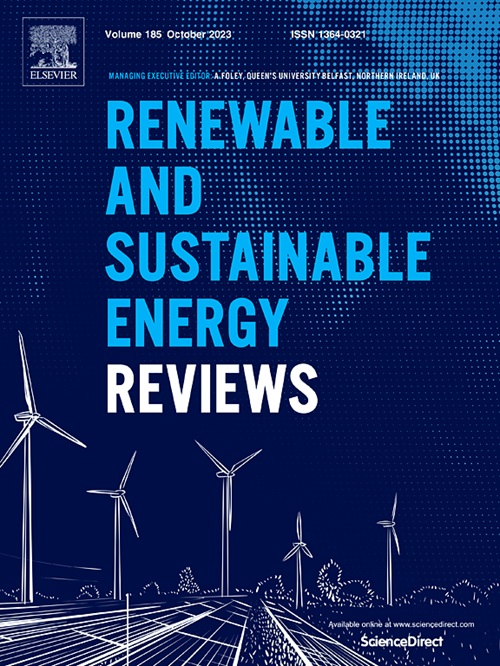微藻生物炼制绿色生物氢的人工智能驱动与预测研究进展
IF 16.3
1区 工程技术
Q1 ENERGY & FUELS
引用次数: 0
摘要
随着全球能源转型的推进,可持续的生物氢生产对于减少温室气体排放和减缓气候变化至关重要。基于微藻的生物制氢是一种有前途的可再生能源,可以作为传统制氢方法的环保替代品。然而,微藻生物制氢的挑战仍然存在于提高产氢率和工艺效率方面。本文综述了利用微藻生产生物氢的传统方法和创新方法。它检查生物光解,暗发酵,并利用应激条件(例如,硫剥夺),以提高氢气产量。此外,还讨论了基因工程和微生物共培养在提高产氢率中的作用。人工智能(AI)应用在通过实时调整关键变量优化制氢方面的作用备受关注。该综述概述了基因改造、代谢工程和人工智能驱动优化方面的重大进展,并展示了如何使用这些技术来提高生物氢产量。人工智能模型已经证明了预测和优化光照强度、温度和营养水平等因素的能力,以最大限度地提高氢气产量。此外,利用计算流体动力学(CFD)与Aspen Plus的模拟技术来评估大规模生物制氢的可行性。人工智能驱动的优化和先进的生物技术方法对于克服当前的局限性和提高效率至关重要。扩大生物氢生产将需要在反应器设计、能源效率和过程自动化方面不断创新。为了充分发挥微藻作为可再生氢的可行来源的潜力,进一步的研究是必不可少的。本文章由计算机程序翻译,如有差异,请以英文原文为准。

Artificial intelligence-driven and prediction of green biohydrogen derived from microalgae biorefinery: A review
As the global energy transition progresses, sustainable biohydrogen production is essential to reducing greenhouse gas emissions and mitigating climate change. Microalgae-based biohydrogen production is a promising renewable source that can serve as an environmentally friendly alternative to conventional hydrogen production methods. However, the challenges of microalgae-based biohydrogen production remain in improving hydrogen yield and process efficiency. This review explores both traditional and innovative approaches to biohydrogen production from microalgae. It examines biophotolysis, dark fermentation, and the use of stress conditions (e.g., sulfur deprivation) to enhance hydrogen yields. Additionally, the role of genetic engineering and microbial co-cultivation in improving hydrogen production is discussed. Artificial intelligence (AI) applications are highlighted for their role in optimizing hydrogen production by adjusting key variables in real-time. The review outlines the significant advancements in genetic modification, metabolic engineering, and AI-driven optimization, demonstrating how these techniques could be used to enhance the biohydrogen output. AI models have demonstrated the ability to predict and optimize factors such as light intensity, temperature, and nutrient levels to maximize hydrogen yield. In addition, simulation techniques using computational fluid dynamics (CFD) with Aspen Plus are utilized to assess the feasibility of large-scale biohydrogen production. AI-driven optimization and advanced biotechnological methods are crucial to overcoming current limitations and improving efficiency. Scaling up biohydrogen production will require continued innovation in reactor design, energy efficiency, and process automation. Further research is essential to fully realize the potential of microalgae as a viable source of renewable hydrogen.
求助全文
通过发布文献求助,成功后即可免费获取论文全文。
去求助
来源期刊

Renewable and Sustainable Energy Reviews
工程技术-能源与燃料
CiteScore
31.20
自引率
5.70%
发文量
1055
审稿时长
62 days
期刊介绍:
The mission of Renewable and Sustainable Energy Reviews is to disseminate the most compelling and pertinent critical insights in renewable and sustainable energy, fostering collaboration among the research community, private sector, and policy and decision makers. The journal aims to exchange challenges, solutions, innovative concepts, and technologies, contributing to sustainable development, the transition to a low-carbon future, and the attainment of emissions targets outlined by the United Nations Framework Convention on Climate Change.
Renewable and Sustainable Energy Reviews publishes a diverse range of content, including review papers, original research, case studies, and analyses of new technologies, all featuring a substantial review component such as critique, comparison, or analysis. Introducing a distinctive paper type, Expert Insights, the journal presents commissioned mini-reviews authored by field leaders, addressing topics of significant interest. Case studies undergo consideration only if they showcase the work's applicability to other regions or contribute valuable insights to the broader field of renewable and sustainable energy. Notably, a bibliographic or literature review lacking critical analysis is deemed unsuitable for publication.
 求助内容:
求助内容: 应助结果提醒方式:
应助结果提醒方式:


